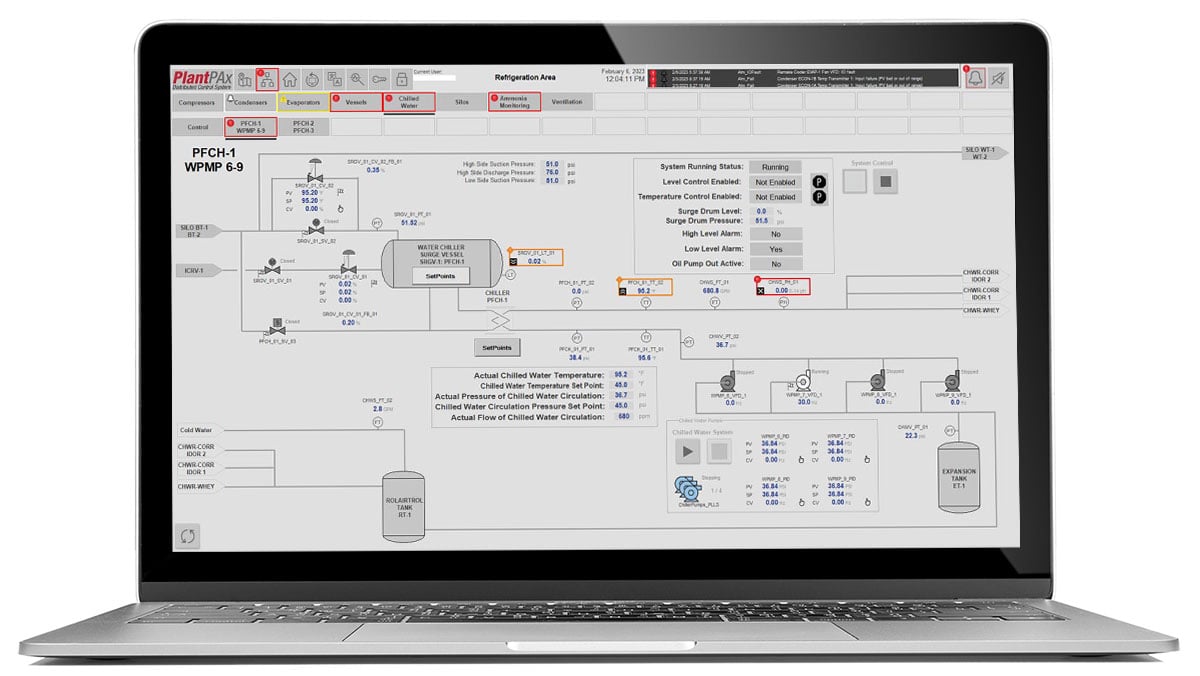A Rockwell Automation PlantPAx 5.0 Solution for a Cheese Manufacturer
A Rockwell Automation PlantPAx 5.0 Solution for a Cheese Manufacturer
A leading dairy cooperative aimed to establish a state-of-the-art greenfield cheese manufacturing facility. Recognizing the importance of advanced control and monitoring systems, the client sought to integrate a Rockwell Automation PlantPAx 5.0 distributed control system (DCS) with their building automation system (BAS) so they could monitor and manage operations as one unified plant. To achieve this goal, Cybertrol, a trusted automation solutions provider, was chosen to lead the project.

The image above is for illustrative purposes only and may not accurately represent the appearance of the client's facility.
The client wanted a SCADA (Supervisory Control and Data Acquisition) system that could monitor the BAS in addition to the plant floor processes, such as flow, temperature, pH, and more. The PlantPAx® 5.0 platform from Rockwell Automation came highly recommended to the client, namely due to its building block structure, its ability the user to seemingly “drag and drop” modules, and that its programming of equipment is much easier. Because the facility was designed from the ground up, the client had the opportunity to implement a state-of-the-art control system which would provide holistic energy monitoring, baselining, and feedback on production and energy usage.
A Hardware Integration to Monitor Both Manufacturing Processes and the Building Management Systems
Cybertrol undertook a comprehensive approach to tackle the client’s challenges. One innovative solution included establishing an on-site trailer for engineers, fostering seamless communication and coordination throughout the project's life cycle. This approach facilitated immediate decision-making, quick problem-solving, and a more efficient way to monitor the progress of the project.
Recognizing the intricacies of interfacing diverse proprietary systems, Cybertrol focused on hardware integration to ensure smooth operation. The SCADA system served as the central control platform, enabling comprehensive monitoring of both the manufacturing processes and the BAS. Real-time rates monitoring the flow and quality of the product, plotted in grayscale per the latest high-performance graphics HMI (Human Machine Interface) standards (ISA-101.01), allowed for streamlined troubleshooting and enhanced maintenance practices. With the new HMI screen, the client has more control compared to past processes, in which a controls engineer may have had to go into the PLC (Programmable Logic Controller) and physically edit the code to get the systems running again.
Cybertrol had to be proactive to bypass the impact of harsh Midwest winter conditions on rooftop equipment installation. Engineers worked closely with the client to devise strategies that enabled safe and quick installation despite the weather. This involved revising installation schedules, leveraging weather forecasts, and coordinating closely with on-site personnel to optimize work periods during favorable weather windows.
Cybertrol engineers had to stay agile and pivot in the face of supply chain disruptions caused by the global pandemic. We used our vendor network and industry partnerships to secure critical components, and in some cases, we identified alternative suppliers and solutions for components that were facing up to six month delays. By seeking out available resources and exploring options beyond the traditional supply chain, Cybertrol ensured that the project's momentum was not compromised by unexpected shortages.

Using a Multi-phased Approach to Successfully Resolve BAS Project Challenges
Phase 1: Preliminary Engineering
Cybertrol provided preliminary engineering services to create the actual BAS bid specification for the project. During this phase, we gathered all available information from the building design drawings, customer standards, and the specifications from the equipment vendors. Working closely with the customer, we determined what was needed for communications between them and created an initial layout of where the hardware needed to be installed to be able to control equipment, monitor the data, get it into the network, and get it onto the HMI system.
Phase 2: Design and Build
Starting with the information compiled for the BAS bid specification, Cybertrol engineers continued the process of updating the BAS design requirements based on approved equipment submittals and changes with the building design information. Typically, a design-build process runs in a consecutive order where complete designs and documentation are approved by the customer prior to component orders, panel fab, or program development. However, due to supply chain issues, there were many occurrences of redesign and component reorders to maintain the project schedule.
Phase 3: Startup
Cybertrol has extensive experience working with customers to perform coordinated startups in either a new construction or running plant environment. Primarily due to supply chain issues, the design and build phase significantly overlapped into the startup phase. This was also compounded by equipment delivery and mechanical/electrical installation delays. These factors led to a combination of schedule compression and shifting BAS startup priorities.
 The image above is for illustrative purposes only and does not depict the actual appearance of the client's facility.
The image above is for illustrative purposes only and does not depict the actual appearance of the client's facility.
The End Result - A New SCADA System and PlantPAx 5.0 Provides Process Visibility
The successful integration of the PlantPAx 5.0 platform established a unified control platform that interconnected both the environmental and process controls. This integration ensured that the various control systems were aligned and could be managed seamlessly from a single interface. The unification represented a departure from the traditional approach, where distinct systems operated in silos that often necessitated complex coordination.
The execution of the SCADA system introduced a drastic shift in usability and troubleshooting. With all controls now centralized and accessible from one interface, maintenance staff gained visibility into the operations of both the manufacturing floor and the BAS. This increased visibility allowed maintenance teams to effectively monitor, diagnose, and address issues, significantly reducing downtime and the need for manual intervention.
The integrated system's ability to collect and analyze real-time data enabled the client to gain insights into energy consumption, process efficiency, and overall system performance that they did not have access to before. This actionable new data allowed the client to begin creating and planning predictive maintenance strategies. By identifying potential issues before they escalate into critical failures, the client is now able to optimize maintenance schedules, extend equipment life cycles, and minimize unplanned disruptions, saving money and time.
The new system also fosters operational synergy by breaking down barriers between different control domains. This allows for comprehensive data aggregation and correlation, enabling the client to make data-driven decisions that transcend individual subsystems. The data-rich environment empowers the client to make informed business choices about energy optimization, process enhancement, and resource allocation, aligning with their commitment to sustainable and efficient operations.

Looking Ahead
As the initial goal for this greenfield project was to be a demonstration plant: the success of the integration paves the way for PlantPAx 5.0 to be rolled out in future plants. The project's duration of approximately two years, spanning various stages, showcases the dedication of both Cybertrol and the client to overcoming challenges and achieving progressive results. The collaboration on this project underscores the potential of integrated systems to enhance operational efficiency and improve maintenance practices. The successful integration of PlantPAx 5.0 with the client’s BAS demonstrates the adaptability and innovation required to overcome challenges in today's dynamic manufacturing landscape.
Looking to integrate your DCS with your BAS? Contact Cybertrol and tell us about your project.
Contact Cybertrol for help integrating plant floor automation systems and building automation systems.
Contact Us
